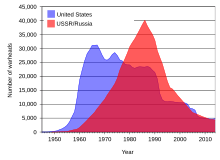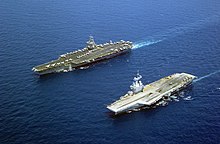List of states with nuclear weapons
In particular, under the Strategic Offensive Reductions Treaty thousands of Russian and US nuclear warheads are inactive in stockpiles awaiting processing.[47] The United States was the first nation to develop the hydrogen bomb, testing an experimental prototype in 1952 ("Ivy Mike") and a deployable weapon in 1954 ("Castle Bravo").Throughout the Cold War it continued to modernize and enlarge its nuclear arsenal, but from 1992 on has been involved primarily in a program of stockpile stewardship.The UK had provided considerable impetus and initial research for the early conception of the atomic bomb, aided by Austrian, German and Polish physicists working at British universities who had either fled or decided not to return to Nazi Germany or Nazi-controlled territories.The UK collaborated closely with the United States and Canada during the Manhattan Project, but had to develop its own method for manufacturing and detonating a bomb as US secrecy grew after 1945.It was also relevant to retain great power status, alongside the United Kingdom, during the post-colonial Cold War (see: Force de frappe).[58] In January 2006, President Jacques Chirac stated a terrorist act or the use of weapons of mass destruction against France would result in a nuclear counterattack.[65] According to Stockholm International Peace Research Institute (SIPRI), China is in the middle of a significant modernization and expansion of its nuclear arsenal.Its nuclear stockpile is expected to continue growing over the coming decade and some projections suggest that it will deploy at least as many intercontinental ballistic missiles (ICBMs) as either Russia or the US in that period.India's secret development caused great concern and anger particularly from nations that had supplied its nuclear reactors for peaceful and power generating needs, such as Canada.The US had further said it is not its intention to assist India in the design, construction or operation of sensitive nuclear technologies through the transfer of dual-use items.[66] North Korea was a party to the Nuclear Non-Proliferation Treaty, but announced a withdrawal on 10 January 2003, after the United States accused it of having a secret uranium enrichment program and cut off energy assistance under the 1994 Agreed Framework.North Korea claimed to have conducted its first hydrogen-bomb test on 5 January 2016, though measurements of seismic disturbances indicate that the detonation was not consistent with a hydrogen bomb.In 2018, North Korea announced a halt in nuclear weapons tests and made a conditional commitment to denuclearisation of the Korean Peninsula;[95][96] however, in December 2019, it indicated it no longer considered itself bound by the moratorium.[97] Kim Jong Un officially declared North Korea a nuclear weapons state during a speech on 9 September 2022, the country's foundation day.There are unconfirmed reports that all or some of the submarines have been equipped to launch an indigenously produced nuclear-armed sea-launched variant of the Popeye cruise missile, giving Israel a sea-based nuclear strike capability.[106] On 7 November 2023, during the Israel–Hamas war, Heritage Minister Amihai Eliyahu said during a radio interview that a nuclear strike would be "one way" to deal with Gaza, which commentators and diplomats interpreted as a tacit admission that Israel possesses such a capability.Information from China is unclear, but "the launch of nuclear weapons is commonly believed to rest with the Central Military Commission of the Chinese Communist Party."[citation needed] Russia grants such power to the President but may also require approval from the Minister of Defence and the Chief of the General Staff.[109] In the United States, some military commanders have been delegated authority to launch nuclear weapons "when the urgency of time and circumstances clearly does not permit a specific decision by the President.British nuclear-armed submarine commanders are issued with "letters of last resort" written by the Prime Minister containing secret instructions which may or may not give them delegated launch authority.However, since all US nuclear weapons are protected with Permissive Action Links, the host states cannot easily arm the bombs without authorization codes from the US Department of Defense.[116] Since June 2023[update],[122] the leaders of Russia and Belarus have claimed that a "number of"[123] nuclear weapons are located on Belarusian territory while remaining in Russian possession.[123] Members of the Non-Aligned Movement have called on all countries to "refrain from nuclear sharing for military purposes under any kind of security arrangements.[143] During the Cold War, specifically during the presidency of Ferdinand Marcos from 1965 to 1986, American nuclear warheads were secretly stockpiled in the Philippines.
Other states presumed to have nuclear weapons (
Israel
)
NATO
or
CSTO
member
nuclear weapons sharing
states (
Belgium
,
Germany
,
Italy
,
Netherlands
,
Turkey
,
Belarus
)








nuclear-armedFranceRussiaUnited KingdomUnited StatesNorth KoreaPakistanIsraelnuclear weapons sharingBelgiumGermanyNetherlandsTurkeyBelarusKazakhstanSouth AfricaUkraineNuclear weaponsNuclear explosionHistoryWarfareDesignTestingDeliveryEffectsWorkersEthicsArsenalsTarget selectionArms raceBlackmailEspionageProliferationDisarmamentTerrorismUmbrellaOppositionWintersovereign statesTreaty on the Non-Proliferation of Nuclear WeaponsformerSoviet Unionnuclear testshave nuclear weaponspolicy of deliberate ambiguitydeterrenceFederation of American ScientistsStockholm International Peace Research InstituteWeapons of mass destructionBiologicalChemicalNuclearRadiologicalBy countryAlbaniaAlgeriaArgentinaAustraliaBrazilBulgariaCanadaMexicoMyanmarPhilippinesPolandRhodesiaRomaniaSaudi ArabiaSouth KoreaSwedenSwitzerlandTaiwanYugoslaviaMissilesList of treatiestreaty partiesstateswarheadsStrategic Offensive Reductions Treatynuclear reactorsAtomic Agedelivery methodsfour acquiring a nuclear triadTrinityAlamogordo, New MexicoRussian FederationSemipalatinskKazakh SSRHurricaneMonte Bello IslandsTrident submarinesGerboise BleueRegganeFrench AlgeriaTriomphant submarinesLop NurXinjiangSmiling BuddhaPokhranRajasthanChagai-1Ras Koh HillsBalochistan9 October 2006North HamgyongHistory of nuclear weaponsUN Security Councilpermanent membersveto powerNuclear weapons of the United StatesUnited States and weapons of mass destructionManhattan ProjectWorld War IINazi GermanybombedHiroshimaNagasakihydrogen bombIvy MikeCastle BravoCold Warstockpile stewardshipRussia and weapons of mass destructionStrategic Rocket ForcesSoviet atomic bomb projectatomic spies